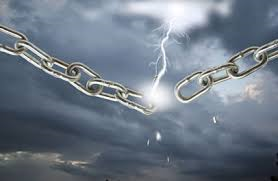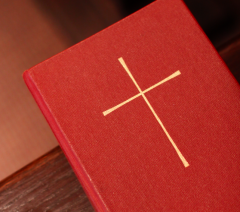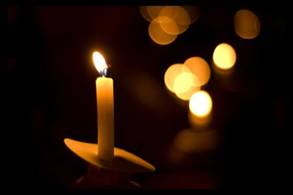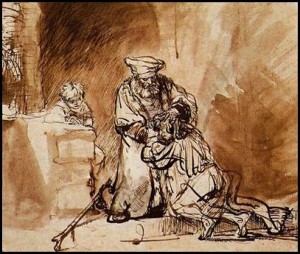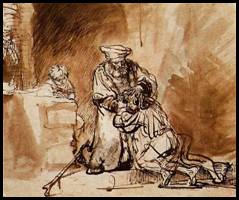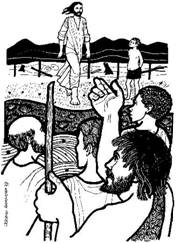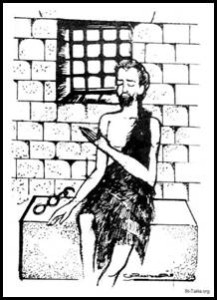Questions for the Journey (1)
Sunday, March 9: First Sunday in Lent
Women of Insight
Matthew 4:1-11
Genesis 2:15-17, 3:1-7
For at least 18 centuries now, men have interpreted these lessons for their congregations. Almost all of these men were taught by (and with) other men; and when they were ordained and moved on to parishes and dioceses, almost all of them lived apart from women.
The more isolated these male preachers were from women and family life, the less they could draw from the insights of women. But the life experiences, reflections and insights of women, if heard, can give the whole congregation a fuller understanding of the Scriptures.
For an example of how a woman’s insights can contribute to fuller understanding of the text, listen to what Julian of Norwich (14th century) wrote and taught:
Julian’s exploration of God’s motherhood is rooted in key aspects of her theology. The persons of the Trinity are for her a dynamic relationship not just with each other, but with us. We are created, restored, and brought to fulfillment in interrelationship with God as Father, Mother, and Lord.
Her identification of the Second Person with Wisdom reclaims the feminine aspect of this biblical symbol. She also uses the traditional symbols of Baptism and Eucharist to see Christ as the one in whom we are reborn and fed, as a mother brings a child forth from her womb and feeds it from her own body.
But central to her view of God as Mother as well as Father is her understanding of divine love as incapable of real anger or rejection of God’s children, no more than a mother could reject her child, even though she might need to appear stern at times to discipline it. But behind even this discipline is a love that can never cease. Julian sees this kind of divine love as mother-like, or rather divine Motherhood as its fullest reality, which we see palely revealed in human mothers.
While this sense of God’s motherhood reflects something of Julian’s experience of women as mothers (or at least her view of what a mother’s love should be), her understanding of sin also reflects a significant shift in perspective that perhaps also reflects her experience as a woman. In sharp contrast to the Augustinian view of sin as overweening pride and concupiscence, Julian views our bondage to sin primarily as our entrapment in an overwhelming sense of fear and worthlessness and as manifest in pain, not pleasure. But once we glimpse God’s continuing love and our own worth in God’s eyes, we can become secure in our trust in God. (from Rosemary Radford Ruether, Visionary Women *)
Matthew 4:1-11 – How do Julian’s insights about the nature of God’s love contribute to your own understanding of Jesus’ temptations in the desert?
Genesis 2:15-17, 3:1-7 The way this text has been used in preaching and teaching over the centuries can be instructive: the story of the temptation and fall has frequently been used to identify Eve as the weaker human being, the cause of Adam’s fall, and the source of original sin. How does that interpretation skew our understanding of Matthew 4:1-11?
Jewish tradition has not interpreted Genesis 2-3 in the same way. What do you think the story meant to the original tellers?
* Visionary Women: Three Medieval Mystics, by Rosemary Radford Ruether.
Fortress Press: 2002.
Questions for the Journey (2)
Sunday, March 16: Second Sunday in Lent
Answers vs. Questions
John 3:1-17
Sometimes, if we really want to grasp the meaning of a Bible passage, we have to become Biblical archaeologists. We need to dig down below the surface to find the earliest layer.
“Biblical archaeology’ is especially necessary whenever we’re reading John’s gospel. The last-written of the four New Testament gospels, it is the product of years and years of reflection. And so John 3:1-17 ends with a profound meditation on the love of God:
God so loved the world that he gave his only Son, so that everyone who believes in him may not perish, but have everlasting life. (John 3:16)
This is John’s long-considered answer to the meaning of Jesus. It is one of the most beautiful (and best-known) passages in the New Testament; over the centuries it has inspired millions of ordinary human beings – along with great poets, artists and musicians – as a fundamental expression of faith in a God of love. (To hear John Stainer’s version of ‘God so loved the world,’ go to http://www.youtube.com/watch?v=X5Akz6J8Rw0 .)
But how does the story begin? When we dig down through the layers, it all begins with a man who has questions.
There was a Pharisee named Nicodemus, a leader of the Jews. He came to Jesus by night and said to him,
Nicodemus: Rabbi, we know that you are a teacher who has come from God; for no one can do these signs that you do apart from the presence of God.
Jesus: Very truly, I tell you, no one can see the kingdom of God without being born from above.
Nicodemus: How can anyone be born after having grown old? Can one enter a second time into the mother’s womb and be born?
Jesus: Very truly, I tell you, no one can enter the kingdom of God without being born of water and Spirit. What is born of the flesh is flesh, and what is born of the Spirit is spirit. Do not be astonished that I said to you, ‘You must be born from above.’ The wind blows where it chooses, and you hear the sound of it, but you do not know where it comes from or where it goes. So it is with everyone who is born of the Spirit.
Nicodemus: How can these things be?
When you reflect on this encounter, what is Nicodemus asking Jesus?

When I reflect on this passage, here’s what I find:
The God of Jesus Christ is a God who invites questions.
Today Nicodemus wonders how he can receive the new birth that Jesus promises through the Spirit. Last week we heard the questions of Paul, pacing his prison cell and wondering about sin and redemption. (Romans 4) Next week we’ll hear questions from the Samaritan woman, wondering about the ‘living water’ that Jesus offers her. (John 4)
You and I do not need to have all the answers before we approach God.
Every spiritual journey begins not with answers, but with questions.
If you were Nicodemus, what questions would you ask Jesus?
Questions for the Journey (3)
Sunday, March 23: Third Sunday in Lent
The Woman Who Was Thirsty
John 4:5-42
Jesus came to a Samaritan city called Sychar, near the plot of ground that Jacob had given to his son Joseph. Jacob’s well was there, and Jesus, tired out by his journey, was sitting by the well. It was about noon. A Samaritan woman came to draw water, and Jesus said to her, “Give me a drink.” (His disciples had gone to the city to buy food.) The Samaritan woman said to him, “How is it that you, a Jew, ask a drink of me, a woman of Samaria?” (Jews do not share things in common with Samaritans.)
Jesus answered her, “If you knew the gift of God, and who it is that is saying to you, `Give me a drink,’ you would have asked him, and he would have given you living water.” The woman said to him, “Sir, you have no bucket, and the well is deep. Where do you get that living water? Are you greater than our ancestor Jacob, who gave us the well, and with his sons and his flocks drank from it?” Jesus said to her, “Everyone who drinks of this water will be thirsty again, but those who drink of the water that I will give them will never be thirsty. The water that I will give will become in them a spring of water gushing up to eternal life.” The woman said to him, “Sir, give me this water, so that I may never be thirsty or have to keep coming here to draw water.”
Why didn’t the Jews ‘share things in common’ with Samaritans?
In Jesus’ time there were strict rules that separated Jews from Samaritans; so in going through Samaria, Jesus is ‘breaking the rules’ of first-century travel. Samaria is in the hill country between Galilee and Judea, and the straightest route for Galileans on their way to Jerusalem. But Galileans usually went around Samaria, rather than through it, because of the tense relationship between Jews and Samaritans.
Both Jews and Samaritans traced their tense relationship back to the Assyrian conquest (722 BC), when the Jews were deported to Babylon. When the Jews returned half a century later, they found those who remained had intermarried with the Canaanites and Assyrians, and despised them for their lack of purity. Both Jews and Samaritans looked for the coming Messiah, but after their exile the Jews rebuilt their temple on Mount Zion, while the Samaritans had a rival temple on Mount Gerizim.
Who is ‘the Samaritan woman’?
In Jesus’ time there were strict rules that separated men from women; so in speaking to this woman, Jesus is ‘breaking the rules’ of first-century gender relationships. Note also that this woman comes to the well in the middle of the day, rather than in early morning with all the other women. (Is she avoiding the other women? Are the village women ostracizing her?) Whatever her status, this woman speaks directly to Jesus, and she questions him without timidity. After talking with Jesus, she leaves her water jar (the reason she came to the well in the first place!) to run back to the villagers (whom she was avoiding) to tell them about him: “Could this be the Messiah?”
Who is this Jesus?
Jesus tells the Samaritan woman, “Those who drink of the water that I will give them will never be thirsty. The water that I will give will become in them a spring of water gushing up to eternal life.” The woman said to him, “Sir, give me this water, so that I may never be thirsty or have to keep coming here to draw water.” Jesus is saying that he has access to the source of living water, the life of the Spirit of God; and the woman, even while giving her sarcastic reply, longs for this living water – because she leaves her jar at the well, and runs back to the village to tell people about Jesus.
What does ‘the bucket’ mean to you?
Last Thursday, as various people commented on this reading, our conversation began to focus on the bucket, which the village women used to draw the water.
Without the bucket, no one could reach the water at the bottom of the well. But while necessary, the bucket is also a symbol of the rules and restrictions we human beings always put around the Holy.
Can the bucket symbolize the boundaries that separate people – the boundaries that divide one people from another (Jews from Samaritans, Russians from Ukrainians, blacks from whites, poor from rich, gay from straight….)?
Can the bucket symbolize the boundaries that separate genders – the social rules that prescribe one way of life for men, another way of life for women? (Note: in my always-reliable Dictionary of the Bible, ‘the Good Samaritan’ (one of Jesus’ stories in Luke’s Gospel) is listed, but there is no entry at all for ‘the Samaritan Woman’ (one of Jesus’ most important encounters in John’s Gospel. Why is this?)
Can the bucket symbolize the boundaries that separate ‘true’ from ‘false’ faiths – the creeds that separate the orthodox from heretics, Jews from Samaritans, Christians from Jews, Catholics from Protestants?
Can the bucket – even as holy a bucket as the church – ever contain all the ‘living water’?
Questions for the Journey (4)
Sunday, March 30: Fourth Sunday in Lent
Seeing through the Eyes of a Woman Preacher
John 9:1-41
What follows is an excerpt from Barbara Brown Taylor’s new book, LEARNING TO WALK IN THE DARK. Barbara Brown Taylor is an Episcopal priest, a renowned preacher, a former parish pastor, and now a seminary professor. I include this excerpt here not only because it is a profound meditation on John 9:1-41, but because it helps us to understand what we are missing when we can’t hear the voices of women preachers.
Light without sight: A different way of seeing
I do not know what darkness means to someone who is blind, but I am beginning to understand that light has as many meanings as dark. There is an old prayer in the Book of Common Prayer that goes like this:
Look down, O Lord, from your heavenly throne, and illumine this night with your celestial brightness; that by night as by day your people may glorify your holy Name; through Jesus Christ our Lord. Amen.
Among other things, this prayer recognizes a kind of light that transcends both wave and particle. It can illumine the night without turning on the lights, becoming apparent to those who have learned to rely on senses other than sight to show them what is real. This is the light the mystics see when they meditate in the night hours, picking up their pens in the morning to write down their revelations. It is the light Moses saw in the darkness on Mount Sinai, where the glory of God came wrapped in dazzling darkness. Dionysius the Areopagite called it “the unapproachable light in which God dwells.”
My guess is that this idea is as incomprehensible to those who have not experienced it as it is indisputable to those who have. No one has described it better for me than Jacques Lusseyran, a blind French resistance fighter who wrote about his experience in a memoir called And There Was Light. Lusseyran was not born blind, though his parents noticed that he was having trouble reading and fitted him with glasses while he was still quite young. Beyond that, he was an ordinary boy who did all the things that other boys do, including getting into fights at school. During one such scuffle he fell hard against the corner of his teacher’s desk, driving one arm of his glasses deep into his right eye while another part of the frame tore the retina in his left. When he woke up in the hospital he could no longer see. His right eye was gone and the left was beyond repair. At the age of seven he was completely and permanently blind.
As he wrote in a second volume, he learned from the reactions of those around him what a total disaster this was. In those days blind people were swept to the margins of society, where those who could not learn how to cane chairs or play an instrument for religious services often became beggars. Lusseyran’s doctors suggested sending him to a residential school for the blind in Paris but his parents refused, wanting their son to stay in the local public school where he could learn to function in the seeing world. His mother learned Braille with him. He learned to use a Braille typewriter. The principal of his school ordered a special desk for him that was large enough to hold his extra equipment. But the best thing his parents did for him was never to pity him. They never described him as “unfortunate.” They were not among those who spoke of the “night” into which his blindness had pushed him. Soon after his accident his father, who deeply understood the spiritual life, said, “Always tell us when you discover something.”
In this way Lusseyran learned that he was not a poor blind boy but the discoverer of a new world in which the light outside of him moved inside to show him things he might never have found any other way. Barely ten days after his accident he made a discovery that entranced him for the rest of his life. “The only way I can describe that experience is in clear and direct words,” he wrote. “I had completely lost the sight of my eyes; I could not see the light of the world anymore. Yet the light was still there.”
Its source was not obliterated. I felt it gushing forth every moment and brimming over; I felt how it wanted to spread out over the world. I had only to receive it. It was unavoidably there. It was all there, and I found again its movements and shades, that is, its colors, which I had loved so passionately a few weeks before.
This was something entirely new, you understand, all the more so since it contradicted everything that those who have eyes believe. The source of light is not in the outer world. We believe that it is only because of a common delusion. The light dwells where life also dwells: within ourselves. (Against the Pollution of the I)
At first I thought he was speaking metaphorically—or perhaps theologically—but as I continued to read, it became clear that he was also speaking literally of an experience of light that had nothing to do with his eyes. With practice, he learned to attend so carefully to the world around him that he confounded his friends by describing things he could not see. He could tell trees apart by the sounds of their shadows. He could tell how tall or wide a wall was by the pressure it exerted on his body.
“The oak, the poplar, the nut tree have their own specific levels of sound,” he wrote by way of explanation. “The tone of a plane tree is entered like a room. It indicates a certain order in space, zones of tension, and zones of free passage. The same is true of a wall or a whole landscape.” If Lusseyran had not already established himself as a trustworthy guide, that might have sounded crazy to me. But since he had won my confidence I was persuaded that I was the one who was handicapped, not he.
Why had I never paid attention to the sounds of trees before? Surely the leaves of an oak made a different sound in the wind than the needles of a pine, the same way they made a different sound underfoot. I just never bothered to listen, since I could tell the trees apart by looking. When a sighted friend told me she had been to a workshop where she learned how to listen to trees, I was taken aback.
“What do they say?” I asked incredulously.
“You don’t want to know,” she replied ruefully. Acid rain, pine beetles, clear-cutting developers—what did I think trees talked about?
The problem with seeing the regular way, Lusseyran wrote, is that sight naturally prefers outer appearances. It attends to the surface of things, which makes it an essentially superficial sense. We let our eyes skid over trees, furniture, traffic, faces, too often mistaking sight for perception—which is easy to do when our eyes work so well to help us orient ourselves in space.
Speed is another problem. Our eyes glide so quickly over things that we do not properly attend to them. Fingers do not glide, Lusseyran points out. To feel a table is a much more intimate activity than seeing it. Run your hands across the top and you can find the slight dip in the middle of the center panel that you might otherwise have missed, proof that this table was planed by hand. After that your fingers work in inches instead of feet, counting the panels by finding the cracks that separate them, locating a burn—sickle-shaped, like the bottom edge of a hot skillet—and a large burl as well. You can smell the candle wax before you find it, noting the dents here and there left by diners who brought their silverware down too hard.
By the time you reach the legs, you know things about this table that someone who merely glances at it will never know. You know that a patch on one of the legs came unglued and fell off sometime during the last century and that someone raised the overall height of the table by adding globes below each foot. Until very recently I would have said that the one thing you cannot tell without looking is what kind of wood the table is made of, but that was before I visited the violin maker who taught me about the sounds of different woods. He used only spruce for the front, he said, and maple for the back. Then he picked up a rough cut of each and rapped them with his knuckles so that I could hear the difference. If the violin maker were blind, I think he could have figured out that the table was made of walnut, heavy and dense from years of slow growth.
If this does not sound particularly spiritual to you, that may have more to do with you than with the table. Every major spiritual tradition in the world has something significant to say about the importance of paying attention. “Look at the birds of the air,” Jesus said. “Consider the lilies of the field.” If you do not have the time to pay attention to an ordinary table, then how will you ever find the time to pay attention to the Spirit?
“Since becoming blind, I have paid more attention to a thousand things,” Lusseyran wrote. One of his greatest discoveries was how the light he saw changed with his inner condition. When he was sad or afraid the light decreased at once. Sometimes it went out altogether, leaving him deeply and truly blind. When he was joyful and attentive it returned as strong as ever. He learned very quickly that the best way to see the inner light and remain in its presence was to love.
In January of 1944 the Nazis captured Lusseyran and shipped him to Buchenwald along with 2,000 of his countrymen. There he learned how hate worked against him, not only darkening his world but making it smaller as well. When he let himself become consumed with anger he started running into things, slamming into walls and tripping over furniture. When he called himself back to attention, however, the space both inside and outside of him opened up so that he found his way and moved with ease again. The most valuable thing he learned was that no one could turn out the light inside him without his consent. Even when he lost track of it for a while he knew where he could find it again.
If we could learn to be attentive every moment of our lives, he said, we would discover the world anew. We would discover that the world is completely different from what we had believed it to be. Because blindness taught him that, he listened with disbelief as the most earnest people he knew spoke about the terrible “night” into which his blindness had pushed him. “The seeing do not believe in the blind,” he concluded, which may help explain why there are so many stories in the Bible about blind people begging to be healed. Whoever wrote those stories could see.
In seminary I was taught to interpret those stories as teachings about spiritual blindness, but no matter how you read them it is clear that Jesus heals only a very small percentage of those who ask for his help. There is also that strange thing he says at the end of a long healing story in John’s Gospel. “I came into this world for judgment,” he says after healing a man who has been blind from birth, “so that those who do not see may see, and those who do see may become blind” (John 9:39).
Before reading Lusseyran I always heard that as a threatening judgment. Now it sounds more promising to me. At the very least it makes me wonder how seeing has made me blind—by giving me cheap confidence that one quick glance at things can tell me what they are, by distracting me from learning how the light inside me works, by fooling me into thinking that I have a clear view of how things really are, of where the road leads, of who can see rightly and who cannot. I am not asking to become blind, but I have become a believer. There is a light that shines in the darkness, which is only visible there.
Even the Man in the Moon is blind tonight. I always wondered why it took three days for significant things to happen in the Bible—Jonah spent three days in the belly of the whale, Jesus spent three days in the tomb, Paul spent three days blind in Damascus—and now I know. From earliest times people learned that that was how long they had to wait in the dark before the sliver of the new moon appeared in the sky. For three days every month they practiced resurrection.
“Amazing grace, how sweet the sound, that saved a wretch like me. I once was lost but now am found, was blind but now I see.” Maybe. Maybe that is how grace works, but tonight it seems equally possible that the grace I need will come to me in the dark, where I too may learn to see the celestial brightness that has nothing to do with sight.
To order Learning to Walk in the Dark, by Barbara Brown Taylor, go to http://harperone.hc.com/barbarabrowntaylor
Questions for the Journey (5)
Sunday, April 6: Fifth Sunday in Lent
The Woman Who Spoke Out
John 11:1-44
In this gospel reading, what happens between Martha and Jesus?
Forget everything you ever learned about Martha, the sister who was so busy in the kitchen that she forgot to pay any attention to Jesus. Here is the real Martha: forthright, not afraid to say exactly what she thinks, even talking back to Jesus.
I imagine Martha and Jesus, the two of them, standing in the dusty road on the outskirts of Bethany, looking each other in the eye. And as they stand there, face to face, Jesus says to her:
“Your brother will rise again.”
Martha says, “I know that he will rise again in the resurrection on the last day.”
(Orthodox Jews believed that when the Messiah came, bringing the end of time, the dead would then rise again.)
Jesus says, “I am the resurrection and the life. Those who believe in me, even though they die, will live, and everyone who lives and trusts in me will never die. Do you believe this?”
(Through Jesus, can life in God actually be available now?)
And Martha says, “Yes, Lord, I trust that you are the Messiah, the Son of God, the one coming into the world.”
We are all afraid of death.
We are afraid of our own deaths; we are afraid of the deaths of those we love. Indeed, we are in great danger of living our whole lives bound up in the fear of death.
We all know nothing can prevent death. We’re all going to die – even Lazarus, in the end, died again. But here’s what trust can do: It can keep us from being overwhelmed by our fear of death.
We all hope for life. And not just continuing physical life for ourselves and those we love; we hope for the emotional and spiritual life that opens our hearts to the world around us. Jesus is saying that to find such life, we must learn to trust. For Martha (and for the writer of this Gospel), faith is trust in the person of Jesus.
What is ‘trust’, anyway?
‘Belief’ can be understood as the things, the truths, we believe in. But the Aramaic word Jesus used, the word our Bible translates as ‘believe’ actually means ‘trust’. And what is trust? As a verb, it means ‘to place my confidence in…’ As a noun, it means ‘assured reliance on the character, ability, strength, or truth of a person’.
In this encounter, Martha, who already has confidence in Jesus as a person, also comes to trust in the power of the God whom Jesus trusts with his life.
Jesus knew he was going to die – and Jesus, just like you and me, was afraid of dying. After the raising of Lazarus in Bethany (so close to Jerusalem, the stronghold of the authorities), Jesus knew his every word and every action was bringing him closer to his death. But the fear of death did not stop him from doing what he was called to do, because he had trust in God.
We all die every day – in everyday defeats, in little deaths both material and spiritual. We die through our worries about the future, through our worries about things we’ve done and said in the past, and we die through our daily worries over things great and small. But trust in God gives us the power to defy those little deaths.
How can we learn to trust?
Every Lent, the church retells the stories of Lazarus and the blind man and the Samaritan woman and Nicodemus – so we can help each other learn to trust, as they did.
Learning to trust enables us to free ourselves from daily habits and life-long patterns – so we can open ourselves to issues of justice and compassion, and open ourselves to loving in spite of fearing.
We can teach each other to trust. What happens when the church not only tells the ancient stories but also works to live them day by day?
- We can learn how to love in spite of our fear
- We can learn how to act in continuing compassion
- We can learn to work for justice and peace, even when our actions bring danger to ourselves.
Trusting gives us the courage to act in love in spite of our fear of death.
This past month, I have been touched by how wonderfully supportive military veterans have been to Rob and me in the aftermath of the death of our son (a veteran himself). And this morning I’m remembering one veteran who told me he had made the iron statues that surround the American flag at Cambria’s Veterans Memorial Hall.
As he was installing the latest of his statues, in memory of the POWs, a woman driving down Main Street parked her car and came up to him to say,
“I want to tell you how sorry I am for what I did years ago. I was one of the people who spat on you veterans when you came home from Vietnam. I have been so sorry for so many years…”
Can you imagine the courage it took her to say this, in spite of her mortification? (Mortification: ‘A sense of humiliation and shame caused by something that wounds one’s pride or self-respect.’ The word is related, of course, to the Latin word for ‘death’)
Can we learn to trust?
Frederick Niedner, who teaches at Valparaiso University, writes: ‘Like Lazarus, we find ourselves terribly hindered by the grave-clothes that still bind us. We can’t walk the walk of the resurrected when we’re still bound by the old habits that the fear of dying has taught us so well. Thankfully, we find ourselves in a community to which Jesus says, ‘Unbind him; let her go.’
Yes, we belong to a community that shows us how to cast off the old grave-clothes, that teaches us how to forget our own mortifications, that demonstrates how to live without fear.
St. Paul never met Jesus in the flesh. But Paul, just like Martha, met Jesus on his dusty road to Damascus. And the power of that encounter with the person of Jesus stayed with Paul the rest of his life. Here’s what Paul wrote many years later, about the power of the love of God. Paul wrote to the Romans,
For I am convinced (I trust)
that neither death, nor life, nor angels, nor rulers,
nor things present, nor things to come,
nor power, nor height, nor depth, nor anything else in all creation,
will be able to separate us from the love of God in Christ Jesus our Lord.
Do we trust this?
